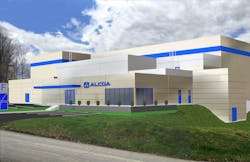Alcoa Takes Investment Plunge into 3D Printing of Metal Parts
With an eye toward advancing 3D printing in the metal industry, Alcoa, supplier of lightweight alumina and aluminum, announced that it has invested $60 million into an expanded facility in Pennsylvania. It will be used for researching and developing new alloy powders and materials in an effort to lower mass-production costs of 3D-printed parts.
In an interview with Fortune, Ellen Lee, Ford’s team leader of additive manufacturing, says that when compared to traditional manufacturing methods, 3D-printing metal parts does not improve efficiency or cost when mass-produced. By achieving a streamlined 3D manufacturing method that uses low-cost materials, Alcoa could lead the way in reforming manufacturing processes.
Additive manufacturing has the potential to reduce metal manufacturing costs by cutting down on scrap metal generated in common subtractive manufacturing. According to the National Institute of Standards and Technology (NIST), starting the design process with 3D models instead of 2D drawings can eliminate steps in the “digital thread,” or the manufacturing process from design to production. Thus, parts could be printed directly from the 3D rendering software used in the design process. Learn more about NIST’s project to standardize 3D modeling for manufacturing.
While 3D printing of metal parts would provide cost and time benefits, metal materials need to be improved for 3D printing before it becomes a large-scale manufacturing process. Ray Kilmer, Alcoa's chief technology officer, says that the R&D facility will be used to develop aluminum, titanium, nickel, and other metals that will reduce the cost of 3D printing, since current alloys used in 3D printing tend to be on the expensive side. New additive-manufacturing processes will also be explored.
Alcoa is currently selling many of its traditional smelting factories to funnel more capital toward future advances in metal 3D printing. The R&D center is expected to start running in the first quarter of 2016.
About the Author
Leah Scully
Associate Content Producer
Leah Scully is a graduate of The College of New Jersey. She has a BS degree in Biomedical Engineering with a mechanical specialization. Leah is responsible for Machine Design’s news items that cover industry trends, research, and applied science and engineering, along with product galleries. Visit her on Facebook, or view her profile on LinkedIn.
